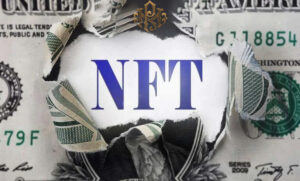
Close



What is money laundering in NFTs and how to fight it? Non-fungible tokens or NFTs are among the most popular trading tools in the world of digital currencies. According to an estimate by Reuters, NFT sales have generated an estimated $90 million in revenue in 2021 alone; But now and beyond its popularity, the problem of money laundering in NFTs is also raised. In this post from Pooyan Music site, we will fully discuss money laundering in NFT.
As with all other technologies, virtual tokens also come with potential risks of abuse and fraud as the price of digital currency grows. The dangers of money laundering in NFT and events such as the hacking of 600 million dollars in the Oxy Infinity game and the theft of 2.8 million dollars from Bored Ape Yacht’s Instagram have caused less people to have a positive view of NFT. In the following, we would like to point out the way of money laundering in NFT with the reasons and how to identify it.

The rules and regulations in the world of NFTs are still in their infancy. Therefore, it is natural that fraud and financial abuse also occur. If we want to think of the crypto world as a galaxy, the NFT market is a newly born planet. NFT Money Laundering is created in the process of paying money or digital currency to buy these tokens.
In other words, there is concern that NFTs may be misused to evade tax laws, launder money or cover up large-scale fraud. For example, a fraudulent person may want to use part of the fraudulent money by trading these tokens. In order to prevent these thefts, an institution called AML, abbreviated as The Anti Money Laundering For NFT, has started to operate.
In addition, according to the 5th EU Directive on AML, any person involved in the purchase or sale of a work of art worth more than 10,000 euros, AML obligations are required to conduct customer due diligence (SDD) and report all suspicious activity to To implement money laundering. As the directive does not address non-fungible tokens, it is unclear whether they are considered artifacts and AML or Know-Your-Customer (KYC) measures.
In 2020, the European Union proposed rules that would also apply to money laundering in NFTs. The Regulation of Digital Asset Markets or MiCA recognizes all these tokens as a type of digital currency and rights that are transferred electronically or distributed ledger technology (Distributed Ledger Technology). These rules and regulations were set up in such a way that AML measures to combat money laundering in NFT are on the agenda.
NFTs can fall under the category of “digital assets”. With this in mind, the anti-money laundering laws in non-equivalent tokens are different in different countries.
Money laundering methods are as varied as a fraudster, thief, or financial criminal can steal in the real world. In general, this work has its own principles and system. According to the definition announced in the guidelines of the Financial Action Task Force or FATF, many of the problems and regulations related to NFTs depend on how they are used and the nature of the asset itself.
The US Treasury warned in 2020 about the risk of money laundering in NFTs, especially in the art sector. The ability to transfer some tokens over the Internet, especially without geographic restrictions, has created the possibility of artistic exploits for criminals.
Also, criminals can launder money by buying just one fake token and later transfer it to their bank account through digital accounts. It is also possible to launder money in NFT by selling to a gullible buyer, creating a high sales record and exiting the market.

There is no evidence that criminals are attacking the NFT market for money laundering. But there are few people who want to launder money by making NFT. For example, a simple way to detect money laundering in NFT is to compare the transaction price with the Fair Market Value. However, due to market price fluctuations, it is difficult to determine a reasonable price for a non-fungible token. By the way, this issue has opened the way for money laundering in the market of this property.
NFT transactions have their own special sections and their transactions are recorded in the general ledger. However, buyers can remain anonymous. This is the biggest advantage of money laundering in NFT. There is currently no system in the market to prevent the creation of multiple user accounts and the transfer of assets to cover up money laundering.
Some critics and experts in the trading world believe that the risks of money laundering in NFT are very high. These people admit that NFTs can be considered the most attractive method for modern money laundering and provide a tax escape route for the rich. The most likely scenarios for this action are phishing, virus attack and fake identity fraud.
In general, all cryptocurrencies have certain characteristics that make money laundering easier, including:
Borderless trading: The market for these assets belongs to the holders of crypto private keys. That is, unlike bank and stock exchange authentication, in NFT transactions, private keys are connected to users’ identities in the real world.
Open Access: Anyone can transact on public blockchain networks without needing to verify their identity. Of course, due to the fight against money laundering in NFT, most of the transactions are done in legal exchanges.
Dynamic market: transactions of these tokens are not limited to geography. Therefore, it is done anywhere in the world without any interference or supervision.
Subjective pricing: The value or price of NFT works are defined instantly and without third parties. That is, the price of a unique token is as much as the buyer is willing to pay for it.
Wash trading is a fake transaction that creates a false image of the value or liquidity of a commodity. This transaction is a kind of market manipulation which is one of the main concerns in the market. With Wash Trading, the trading volume can be made unrealistically high (usually very high) so that other people will trade in order to keep the criminal’s assets.
Wash trading in the NFT world makes traders connect only to their digital wallet and start trading without any knowledge.
Wash trading is just one form of fraud through the NFT market. The most common methods of financial abuse in NFT are as follows:
Consider a money laundering transaction in the NFT market; In this transaction, the criminal seller can buy a cheap token using a set of cryptographic keys. It can then repurchase the token with a trusted third party using different keys, thus creating a fake sale record.
In this way, he bypasses the legal prohibition. In NFT money laundering, if the right considerations are made, it is impossible to connect different sets of one person’s cryptographic keys.
The first and most important steps to reduce NFT money laundering risks are as follows:
Businesses concerned about money laundering and fraud in non-fungible token transactions should consider AML processes and measures. In addition, these companies and institutions should add NFT management to the risk assessment stage and benefit from an integrated approach of digital currencies, AML measures and the non-traditional token market.
AML strategies to combat money laundering in NFT are as follows:
How to launder money in NFT is very simple. We all generally have a clear picture of money laundering in the surrounding world. For this, financial criminals set up cafes, restaurants, car washes, etc., but the criminals of the crypto world have another tactic. In this article of Pooyan Music crypto news, we discussed money laundering in the NFT world in detail. We hope that the content of this article was useful for you.